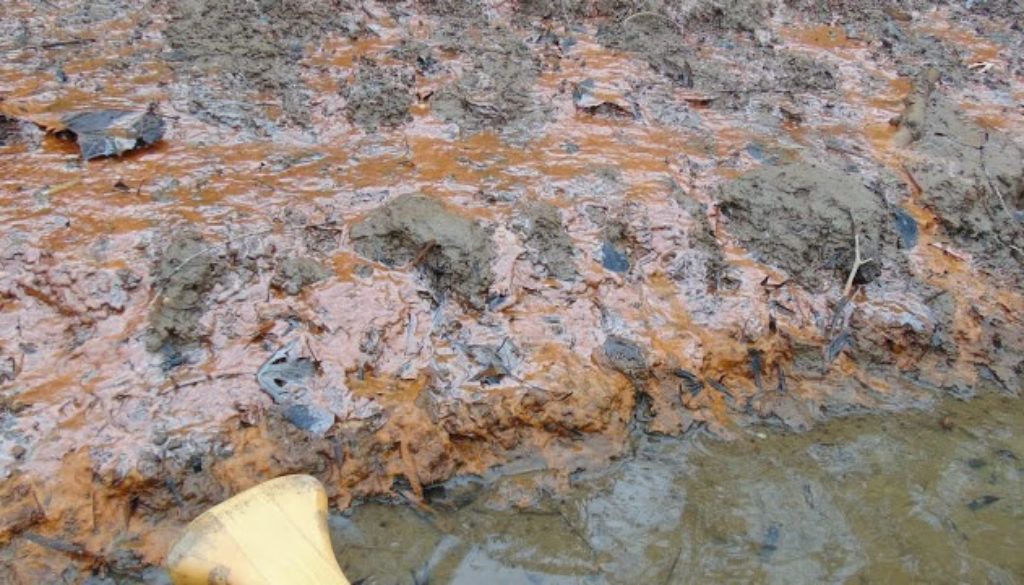Leaking and Looming, Legacy Coal Ash Ponds Spew Poisons. Is There One Near You?
By Lisa Evans, Earthjustice
Legacy ponds are the walking dead of the coal ash universe – toxic waste sites that live long after coal plants have closed, slipping through regulatory cracks as they continue to poison communities. After years of delay and in clear violation of a court order, the Environmental Protection Agency still has not addressed this urgent issue. It is therefore critical for communities living near these toxic threats to speak up about their harms and demand protection.
Coal ash is what is left behind when power companies burn coal for energy. For decades, utilities have gotten rid of it by mixing it with water and dumping it into unlined ponds, where its toxic chemicals—which have been linked to cancer, heart disease, reproductive failure, and stroke—leach into groundwater.
In 2018, the D.C. Court of Appeals ordered the EPA to address this looming threat, but the Trump administration has kicked the can down the road, focusing instead on rollback after rollback that gut the essential protections of the 2015 Coal Ash (CCR) Rule. The EPA is in clear violation of the court’s landmark order designed to tackle the cleanup and containment of millions of tons of coal ash around the United States.
In August 2018, the court directed the EPA to establish stringent safeguards requiring the safe closure and cleanup of more than 100 “legacy” ash ponds located at retired power plants. These rules would apply specifically to plants that closed before the effective date of the federal CCR Rule in October 2015. But five years after the CCR Rule was signed and two years after the court demanded action, the EPA has done nothing to address this threat to human health and the environment.
Legacy ponds are leaking hazardous chemicals. We know this because the utility industry’s own data reveal that regulated ash ponds at nearly all U.S. coal plants contaminate groundwater with toxic chemicals above health standards.
Yet Trump’s EPA has failed to establish actual health-protective regulations. We have learned that the agency will soon simply issue a request for additional information. This tepid response mainly buys time for industry, even as these sites poison drinking water and scenic rivers. This ongoing pandering to the utility industry threatens human health and the environment while blighting the economies of each neighboring community.

It is a travesty that the EPA did not – two years ago – use its authority to require utilities to provide information about their toxic pits. As with COVID-19, the Trump administration eschews the value of information that could save lives.
The reality is that these decades-old ash ponds have escaped maintenance and inspections for many years, while the pits continue to deteriorate and leak toxic chemicals. The massive 2014 spill at Duke Energy’s Dan River Station, which fouled 70 miles of river in two states, was caused by a coal ash pond no longer in use. The Trump administration’s EPA, in direct violation of the court order, has given the utility industry a free pass to abandon leaking pits containing millions of tons of toxic waste—with zero accountability.
Here is a sampling of the ongoing damage:
- Harm to a treasured river, recreation and the local economy: In Oakwood, Illinois, 70-year old unstable pits at the retired Dynegy Vermilion Power Station are leaking toxic chemicals in Illinois’ only National Scenic River. The pits hold more than 3 million tons of toxic waste and run along the river for a half-mile where fishing and boating is revitalizing a struggling area.
- Damage to drinking water and redevelopment: In Lawrenceburg, Indiana, leaking ash pits at AEP’s retired Tanners Creek Plant are contaminating groundwater with high levels of boron within 500 feet of public drinking water wells and the Ohio River. The failure to clean up the ponds threatens the community’s health as well as prospects for redevelopment of the blighted site.
- Damage to drinking water and a threat to millions: In Richmond, Ohio, six 68-year old pits containing 10 billion pounds of toxic ash cover nearly 170 acres and threaten the Ohio River, a source of drinking water for more than 5 million people. The ponds have already contaminated drinking water in Clermont County, causing the shutdown of wells serving thousands of residents. Worse still, the site has a history of spills from the dams, rated by EPA to be in “poor” condition in 2010.
- Unstable dam threatening a state highway: Failure to properly close the high-hazard coal ash pond at the former Sunbury Generation Plant in Shamokin Dam, Pennsylvania, resulted in the rerouting of the Central Susquehanna Thruway. Finding that the underlying ash had the consistency of “toothpaste,” local officials declared the pit unsuitable as roadway base. The ash, still in contact with groundwater, is likely contaminating nearby wells, as well as threatening the Susquehanna River. In 2010, EPA found the same dam in “poor” condition.
- Eighteen years “closed,” but still contaminating groundwater: Georgia Power hasn’t generated power at its defunct Plant Arkwright for nearly 20 years, but its unlined abandoned ash ponds are continuing to leak toxic chemicals, such as boron, above health standards into the groundwater and nearby Ocmulgee River, according to a peer-reviewed study.
A preliminary analysis identified more than 150 of these potential toxic ponds at more than 60 sites around the country, many of which lie in areas that federal emergency managers have labeled a high risk for flooding:
What can communities near abandoned ponds do? You can help Earthjustice identify the toxic pits and call attention to the urgency of this problem. Let us know where you’re located and share your comments with us:
You can also download our community Toolkit to Advocate for Coal Ash Cleanups. Although the toolkit is focused on sites that are currently regulated, it can serve as a guide to help you take action.
We can shine a bright light on the need to properly close these ponds and address the contamination that is occurring. The walking dead do not discriminate. The Trump administration and utilities are closing their eyes, but the threat looms for all Americans near these toxic waste sites.

